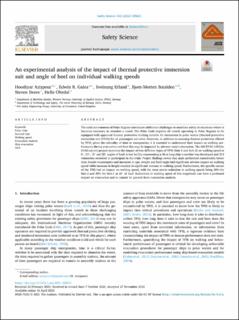| dc.contributor.author | Azizpour, Hooshyar | |
| dc.contributor.author | Galea, Edwin R. | |
| dc.contributor.author | Erland, Sveinung | |
| dc.contributor.author | Batalden, Bjørn-Morten | |
| dc.contributor.author | Deere, Steven | |
| dc.contributor.author | Oltedal, Helle Asgjerd | |
| dc.date.accessioned | 2022-09-29T08:56:02Z | |
| dc.date.available | 2022-09-29T08:56:02Z | |
| dc.date.created | 2022-06-08T18:16:19Z | |
| dc.date.issued | 2022 | |
| dc.identifier.citation | Azizpour, H., Galea, E. R., Erland, S., Batalden, B.-M., Deere, S., & Oltedal, H. (2022). An experimental analysis of the impact of thermal protective immersion suit and angle of heel on individual walking speeds. Safety Science, 152:105621. | en_US |
| dc.identifier.issn | 0925-7535 | |
| dc.identifier.uri | https://hdl.handle.net/11250/3022489 | |
| dc.description.abstract | The cold environment of Polar Regions introduces additional challenges to maritime safety in situations where it becomes necessary to abandon a vessel. The Polar Code requires all vessels operating in Polar Regions to be equipped with approved thermal protective clothing suitable for immersion in polar waters (thermal protective immersion suit (TPIS)) for all passengers and crew. However, in addition to assessing thermal protection offered by TPIS, given the criticality of time in emergencies, it is essential to understand their impact on walking performance during evacuation and how this may be impacted by adverse vessel orientation. The ARCEVAC (ARCtic EVACuation) project examines the impact of two different types of TPIS (Suit-1 and Suit-2) on walking speed at 0°, 10°, 15° and 20° angles of heel. A test facility representing a 36 m long ship’s corridor was developed and 210 volunteers recruited to participate in the trials. Project findings reveal that male performed considerably better than female counterparts and increases in age, weight and heel angle had significant adverse impact on walking speed while increase in height resulted in significant increase in walking speed. Furthermore, the specific nature of the TPIS had an impact on walking speed, with the most severe reduction in walking speeds being 38% for Suit-2 and 29% for Suit-1 at 20° of heel. Reductions in walking speed of this magnitude can have a profound impact on evacuation and so cannot be ignored from evacuation analysis. | en_US |
| dc.language.iso | eng | en_US |
| dc.publisher | Elsevier | en_US |
| dc.rights | Navngivelse 4.0 Internasjonal | * |
| dc.rights.uri | http://creativecommons.org/licenses/by/4.0/deed.no | * |
| dc.title | An experimental analysis of the impact of thermal protective immersion suit and angle of heel on individual walking speeds | en_US |
| dc.type | Peer reviewed | en_US |
| dc.type | Journal article | en_US |
| dc.description.version | publishedVersion | en_US |
| dc.rights.holder | © 2021 The Authors. | en_US |
| dc.source.volume | 152 | en_US |
| dc.source.journal | Safety Science | en_US |
| dc.identifier.doi | 10.1016/j.ssci.2021.105621 | |
| dc.identifier.cristin | 2030315 | |
| dc.source.articlenumber | 105621 | en_US |
| cristin.ispublished | true | |
| cristin.fulltext | original | |
| cristin.qualitycode | 2 | |

